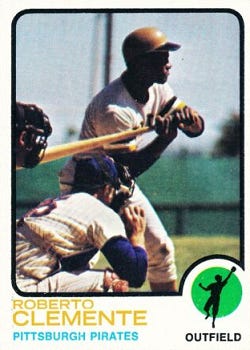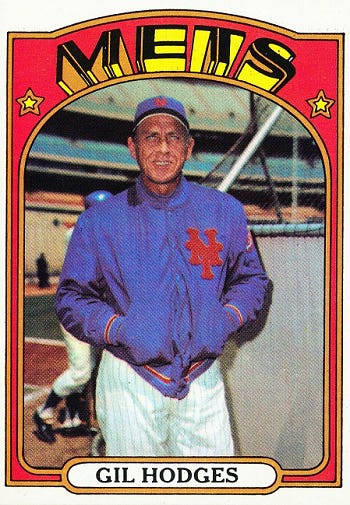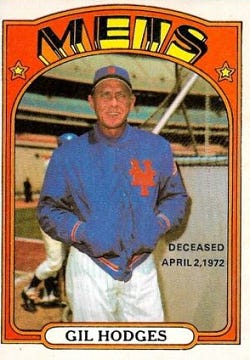One of the most chilling baseball card images from the 1970s was the shadowy profile shot of Robert Clemente in the batter’s box on his 1973 Topps card, issued just months after his tragic death.
Check prices on eBay (affiliate link)
That was the same year — 1973 — that the New York Mets surprised the baseball world by squeaking out a division title, downing the Cincinnati Reds in the NLCS, and taking the Oakland A’s to Game 7 before losing the World Series.
The Mets’ 82-79 record was the worst-ever for a pennant winner and represented a step down — they had won 100 games in 1969 and 83 in each of 1970 through 1972.
Of course, the first season in that run was the year of the Miracle Mets, when manager Gil Hodges led a group of youngsters and journeymen to a World Series title. This, in just their eighth season in existence, and after finishing with historically bad records nearly every summer of the 1960s.
That victory, and the continued winning records into the 1970s, further cemented Hodges’ legend in New York.
Still just 47 years old on the eve of the 1972 season, Hodges had starred at first base for the Brooklyn Dodgers throughout the 1950s, bringing a steady and calm influence to a star-studded franchise that finally dispatched the hated Yankees in the 1955 World Series.
After moving with the Dodgers to Los Angeles in 1958, Hodges returned to New York to play for the expansion Mets in 1962 and 1963.
A trade to the Washington Senators in May of 1963, though, prompted Hodges to retire so that he could focus on his new title — manager.
Five years later, he was back in New York — again — as skipper of the woeful Mets.
Four years after that, on April 2, 1972, Hodges was in Florida playing golf with a group of Mets coaches.
Normally, the whole group would have already headed north for the new season, but a player’s strike had put the brakes on Opening Day.
And it was there, in West Palm Beach, that the Dodgers and Mets legend collapsed as the group was heading back to their hotel. He would die at a local hospital just minutes later.
The news spread through the game, from the group of men gathered there with him, to the Mets, to the other teams, to the media, to the fans.
It was a wholly different kind of shock than the one wrought by Hodges’ 1969 world-beaters, more sudden, more crushing.
A legend was gone, much too soon.
But later that summer, he was back, greeting collectors from card #465 in the 1972 Topps set …
Check prices on eBay (affiliate link)
It must have been a surreal experience to pull that card from a fresh wax pack, to stare into those piercing blue eyes, and to know that the man who had spent so much of his life on green diamonds was gone forever.
As if to punctuate the point, the O-Pee-Chee version of Hodges’ last card spelled out the cold, hard truth right there on the card front: DECEASED APRIL 2, 1972.
Check prices on eBay (affiliate link)
It was a reminder that hardly anyone needed, as the game still reeled from the shock, even as Yogi Berra assumed the role of legend-manager for the Mets.
But, while Hodges never got a proper goodbye, he’s still there, giving us a parting shot across the ages, on that eerie 1972 Topps card.






